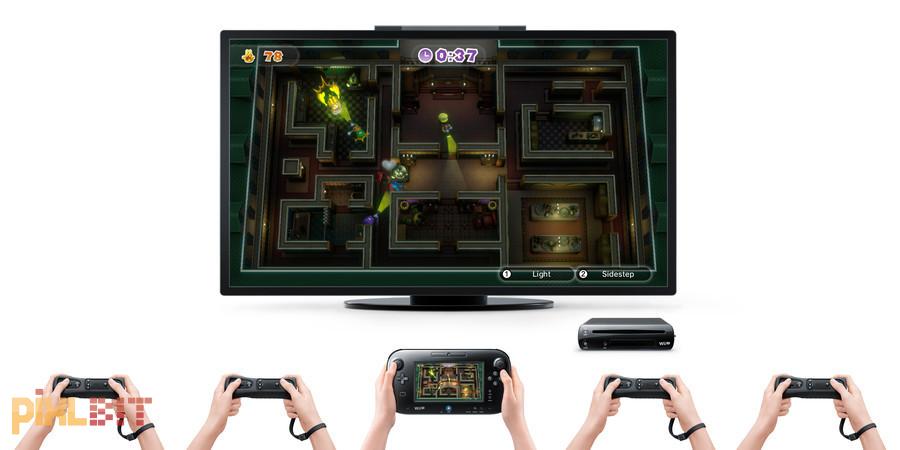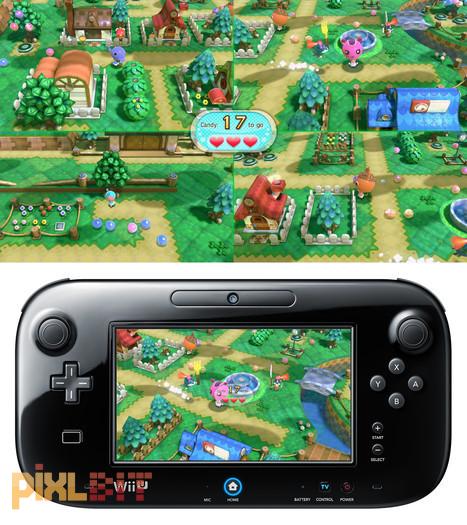Nintendo Land Review
|
|
See PixlBit's Review Policies

On 11/24/2012 at 08:46 PM by Nick DiMola Can we get one of these in real life? |

For everyone.
Upon picking up my Wii U, getting Nintendo Land was something of an inevitability. I can’t say I was particularly excited for it, but I knew it was coming part and parcel with my Deluxe system. Surely New Super Mario Bros. U was going to get the bulk of my attention because, well, it’s Mario. But on a whim, I decided to break the system out of its box and try this flagship title first. While I can’t ask New Super Mario Bros. U how it feels (being a game and all), I can only assume it’s pretty upset as it has spent most of its life in its box thus far. Yes, Nintendo Land is that good.
Being a pack-in, Nintendo Land will surely be compared heavily to Wii Sports, but there’s nothing to compare here. While that was more a showcase of the Wii system and less a game, Nintendo Land is the complete opposite. It’ll teach you how to use your fancy new GamePad and it’ll also show you how the system plays nicely with all of the Wii gear you’ve collected over the past 6 years, but more importantly, it’ll challenge you and provide you with immeasurable fun for up to 5 players.
Split into a total of 12 attractions, Nintendo Land isn’t so much about the amusement park itself; that’s just a boring old circle with a tower in the middle. However, each attraction is a world unto itself, consuming some Nintendo property and presenting it in a soft and approachable art style that unifies the disparate worlds Nintendo has created.
Like any theme park, much of the fun you get out of your time spent there will depend on whom you’re visiting with. As you might expect, a bigger group will be rowdier and more fun, especially for the competitive attractions. A group of two to three is perfect for the cooperative attractions and for those going it solo, there’s a set of 6 attractions made exclusively for the occasion.
The solo attractions, which include Captain Falcon’s Twister Race, Balloon Trip Breeze, Takamaru’s Ninja Castle, Donkey Kong’s Crash Course, Yoshi’s Fruit Cart, and Octopus Dance, are all built with a ramping challenge level and high score chasing. Each game takes use of some feature of the Wii U GamePad to showcase just what it can do, but rarely are these controls shoehorned into an otherwise functional experience. Not just apt, they’re preferable to any other means of control that could be provided.
Donkey Kong’s Crash Course and Balloon Trip Breeze stand out from the crowd, especially for seasoned gaming veterans, as they are both challenging and fun. Crash Course has players tilting around a small device down an obstacle course in order to reach the Princess. Along the way it’s necessary to move platforms via the control sticks and buttons, all while executing perfect tilt control with the GamePad. Given the high level of challenge in just passing through the first course, I found myself continuously coming back for more in an attempt to get through the whole course.
Balloon Trip Breeze has players controlling the wind by blowing their Mii around the screen to pop balloons and fell enemy floaters. Incremental check points allow players to regain their lost balloons and reap a bonus before setting off on the next leg of the trip where weather conditions and enemy frequency is sure to change.
While attractions like Captain Falcon’s Twister Race and Yoshi’s Fruit Cart are fun, it’s only in limited bursts. Takamaru’s Ninja Castle and Octopus Dance are easily the weakest ones and won’t see much playtime for most players, especially when the ten other attractions are so much better.
If you only have one other person in tow, there’s no question that the cooperative games are the best choice. Based in the Zelda, Metroid, and Pikmin universes, you will occupy the role of a given character in each series and work with your partner to complete the level-based quest.
The Legend of Zelda: Battle Quest is an evolved version of the sword-fighting quest in Wii Sports Resort. Up to four players can grab a Wii Remote (with Motion Plus) and fight off enemies with 1:1 sword control. The extra ability to both block and perform the charge attack from Skyward Sword deepens the experience to a degree, but the addition of an archer on the GamePad brings it to new heights.
With this new role, players must remain in constant communication to eliminate both near and far foes. Because drawing an arrow and aiming stops the progression, players must be cognizant of what their partner is doing in order to avoid progressing too far forward and becoming vulnerable to enemy archers. Given the high level of strategy and the challenging courses, Battle Quest is one an attraction that will draw constant attention if you have the right partner handy.
Metroid Blast on the other hand doesn’t encourage the same level of cooperation, but offers an engaging arena-style shooter that throws wave after wave of enemy at your team of up to 5. Those with the GamePad pilot Samus Aran’s ship and patrol the skies, while the rest of the team takes to the ground to fend off smaller foes. If one happens to grapple beam the ship, they’ll be taken for a ride and offered a rapid-fire shot. Additions such as this provide a degree of strategy, but nothing quite like Battle Quest. Nevertheless, Metroid Blast offers pure, unadulterated fun, especially for core gamers.
Pikmin Adventure, while more of a linear beat-‘em-up than a full-fledged Pikmin game, is still engaging thanks to the unique staples of the series. Those with Wii Remotes occupy the role of the plant creatures, while the GamePad holder becomes Olimar, tossing Pikmin on blocks and enemies alike. Because there’s little to no need to play cooperatively, Pikmin Adventure is fun for larger groups as well, but not quite as intriguing as the competitive attractions.
That being said, the attraction’s depth is truly revealed when trying to achieve a master rank on each level. It requires precise execution to avoid being hit and reaching the ship within the prescribed time limit. Suddenly, every step counts and making tough decisions about which power-ups to grab and which to leave becomes commonplace. It’s an exhilarating experience when played in this capacity.
Mario, Luigi, and Animal Crossing see representation in Nintendo Land with competitive attractions. With a large group, you can’t go wrong with these – they all require teamwork to eliminate the GamePad holder, who is put at a distinct advantage.
Mario Chase has the GamePad holder running from Toads, who can only see things from a third person perspective inside the course. Mario on the other hand knows where his foes are and must outwit them while the others communicate and formulate flanking strategies. Animal Crossing: Sweet Day plays out very similarly, except it reverses the roles. The GamePad holder must chase down those with Wii Remotes, who are all collecting candy. If the player with the GamePad can catch his foes before they’ve collected enough candy, he is the winner.
Both offer exciting gameplay given the right audience, but only in short bursts. They’re best enjoyed in the middle of the rotation amongst some of the other attractions in the park, such as the final competitive attraction, Luigi’s Ghost Mansion.
His attraction puts a spin on the cult classic Pac-Man Vs. In this one, the GamePad holder takes the role of a ghost and must hide from the ghost hunters, while simultaneously trying to sneak up and scare them 3 times. Ghost hunters are given flashlights and must ferret out the lurking ghost by using visual and tactile cues (the rumble increases as the ghost comes nearer). Hitting the ghost with the flashlight begins to deplete his life, so the ghost hunters must work together to trap the ghost in hallways and corners. While the teamwork required is similar to both Mario and Animal Crossing, the cat and mouse nature of the chase makes it far more tense and fun.
It’s easy to lose yourself in Nintendo Land because the games contained within are all so good. With a group of any size, it’s easy to jump in and immediately start having fun, something that didn’t hold true for one or two simultaneous players in its spiritual predecessor, Wii Sports. Also unlike Wii Sports, almost every game in the package has some longevity and goals.
Each game offers a number of stamps to collect for performing certain feats, ala achievements, master challenges, and the ability to earn coins. These coins are used in a plinko-style game that nets a prize when each level is completed. Not only is the plinko game itself fun and addicting, but the trinkets and songs earned through the process are fun to interact with and see occupying your park. Attractions are frequently made eligible for earning double coins, which provides further inspiration to play and succeed.
After nearly a week with my Wii U, I still cannot pull myself away from Nintendo Land. With the mountain of content contained, I’ve still not finished most of the challenges, nor earned the stamps and gold trophies associated with top performance. While it’s likely Nintendo built Nintendo Land for the same reasons they built Wii Sports, the end result is something that will hit home with their new audience of choice first and foremost (core gamers), while also ensnaring the casual crowd in the process. If the added hard drive space and digital deluxe promotion weren’t enough to grab the Deluxe Wii U model, Nintendo Land certainly makes it the must-have version of Nintendo’s new system.


















Comments